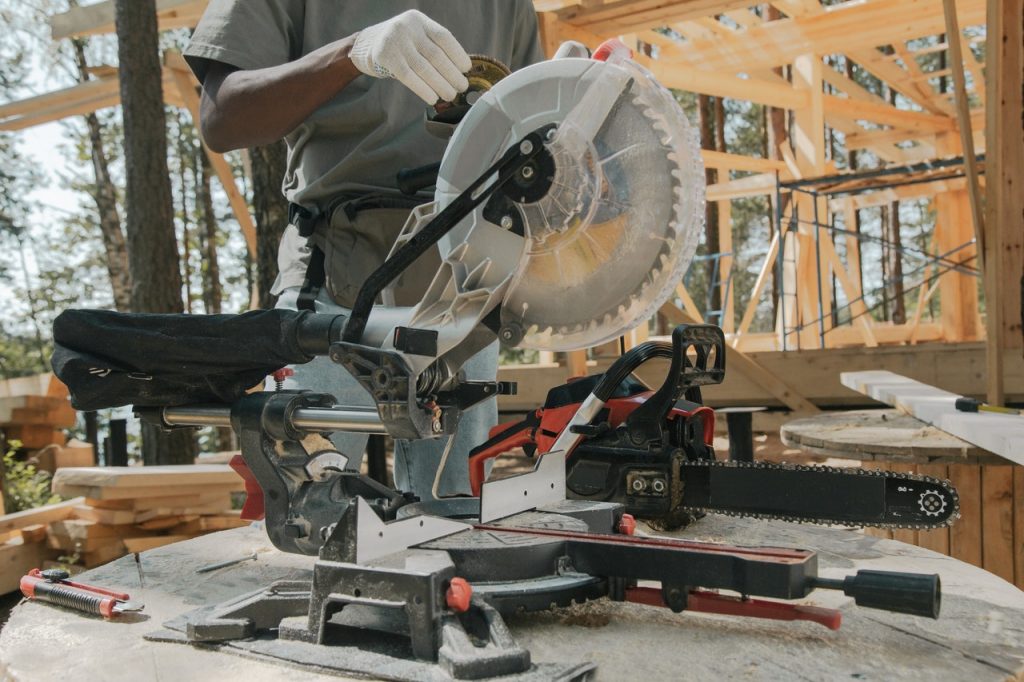Miter saw is a specialized circular saw designed to do various types of cuts such as crown molding, ripping, cross-cutting, etc.
Miter saw is a tool that has three different types: Standard Miter saw, Compound miter saw and Sliding Miter saw. All of these have features which improve the next from the last.
A sliding miter saw has all the features of other miter saws plus the sliding rails.
Quick Summary
In this article, we will be discussing
- The technical details of a Sliding miter saw
- How sliding miter saw functions vs non-sliding miter saw
- Some of the queries related to sliding miter saws
Let’s start
Sliding Miter Saw – All the major details
As discussed above, a sliding miter saw or compound sliding miter saw has all the main functions of a basic miter saw plus other small but equally important features.
What makes sliding miter saws different from non-sliding miter saws is that they feature a sliding mechanism based on sliding rails.
These rails allow the saw to easily cut through the length of the wood or allow the blade to slide back and forth through the saw.
The advantage of these rails is that they allow the miter saw to cut through larger sections and the width of boards is typically up to 12 inches wide.
Compared to non-sliding miter saws, these saws are more versatile as they allow adjustment of the lumbar and the angle of the blade according to your needs.
When should I use a sliding miter saw?
A sliding miter is utilized best when you are working with larger boards that have a width upwards of 10 inches. Some models can cut through 16-inch boards depending on the diameter of the saw blade.
Sliding miter saws also have increased cutting capacity making them well suited to heavy jobs such as DIY projects. Sliding saws are also easy to handle but weigh more than other kinds of saws making them a tool for the workshop.
What kinds of cuts can be made on a sliding saw?
Sliding miter saws usually have dual bevel angles making them capable of making bevel or angled cuts in both directions. This combined with the rail mechanism of the saw makes it an all-around good investment.
You are also able to do the basic types of cuts with a sliding saw albeit many accurate cuts. These include chopping, ripping, compound cuts, and miter cuts.
Does the blade size matter?
The blade size will determine the length up to which the saw can cut. Sliding compound miter saws can easily cut through 12-inch boards. However, some models with bigger diameters can cut up to 16-inch materials too.
You can fit your saw with either a 10-inch blade or a 12-inch blade. 10-inch saws are usually rated to cut up to 12-inch material or 2 x 12. Bigger blades can cut up to 16-inch materials or 2 x 16s.
Pros and Cons
Sliding Miter saws aren’t without their strengths and weaknesses vs non-sliding miter saws. Some of the major pros and cons of a sliding miter saw are as follows.
- Sliding miter saws have a large cutting capacity and can easily cut larger boards in length
- You need a miter saw to make crown molding or other kinds of corner cuts.
- Sliding miter saws are heavy and have portability issues as well as high prices vs non-sliding miter saws
- Sliding miter saws can’t cut at extreme angles due to the rails unlike non-sliding miter saws
All the things you need to know about a miter saw
As discussed above, compound miter saws have different aspects and are designed for specific purposes.
This might make the choice of which miter saw to buy tricky for you as the market is oversaturated with different options.
To help you make an informed decision, let’s go through some of the main factors of a compound sliding miter saw you need to be aware of.
Power
Miter saws can either be corded or cordless. Regardless, both options have almost the same standard engine and cutting output. These are 15 amps and output between 3200 and 5000 RPM.
Both of these have their benefits and drawbacks making them suitable for a specific job.
Corded Miter saws
These miter saws have incredible output. Normally, corded miter saws can give an output of 5000 RPM.
Corded miter saws are also popular in different sizes, particularly in 10 inches and 12-inch sizes. This makes this an exceptional power tool if you are looking to cut through stacks of wood with ease.
Cordless Miter Saws
These are powered by a battery. A good advantage of cordless miter saws is that their batteries can be exchanged with other power tools.
Cordless miter saws are also lightweight and handy for on-the-go jobs.
Table
The table of a miter saw is the base to which the saw is attached. The base is an important feature of a miter saw as it has angle markings as well as positive stops.
Most saws come with a table with markings between 0 and 45 degrees as well as 10 to 12 positive stops to position the blade according to the angle at which you want to make cuts to the lumber.
To make a bevel cut or a miter cut, just slide down the pivoting arm of the compound sliding miter saw after adjusting the angle of your saw.
Blades
Keep in mind that different blades have different purposes. Each type of blade has a different number and type of teeth.
There are ripping Blades. These have a low tooth count and are made for cutting through the fibers of the lumber or ripping. They have a tooth count of about 30.
A miter saw usually comes fitted with a compound blade. Compound blades can do both ripping and crosscutting and have about 60 teeth.
Cross-cutting blades are made for cutting along the width of the wood. These have a high tooth count of more than 80 in total.
Other Features
Some other features can improve your overall experience and enhance the results.
Firstly there are guidance systems for better accuracy when cutting. Miter saws come with either an LED guide or a laser system installed. These can also be bought from the market and installed on some saws.
They work by serving as a visual aid as to where the blade will cut through the wood.
There is also a collection system on saws. It is made to collect the sawdust produced by the blades cutting through the lumber.
Types of cuts that can be made with a miter saw
You can make straight or angled cuts along the length or width of the wood. Rip and cross-cutting can be easily done with a compound miter saw or non-sliding miter saws. Compound sliding miter saws can make miter and bevel cuts.
Following are the ways you can make these cuts using the pivoting arm of the compound miter saws.
Bevel Cuts
Bevel cuts are a type of angled cuts. These are cut at angles other than 90 degrees and are along the width or the length of the wood.
You may have heard of a compound miter saw that has a dual bevel or an argument about single or dual bevel miter saws. This refers to the top or the bottom bevel of the boards.
Bevel cuts are used to join two pieces of wood together which adds to the overall structural integrity of the build and is particularly helpful for crown moldings.
To make bevel cuts, you need to first set the saw blade to the desired angle. You can set it on a positive stop for the common angles or use the tally markings on the board.
After setting it to the desired angle, you can slide the board through the saw blade.
Crosscuts
Crosscuts are made along the width of the lumber. You can easily make compound cuts with your sliding miter saw.
Just set your saw to 90 degrees and cut the width of the material.
Rip Cuts
Rip cuts are made along the length of the wood. A ripping blade has fewer teeth as they have to cut through the fiber of the wood.
Like cross-cutting, set your sliding miter saw to 90 degrees and cut the materials lengthwise.
Miter Cuts
Miter cuts are also angled cuts that can be along the length or the width of the board. To make a miter cut, you first need to measure the angle you want to cut at. These are particularly helpful in making moldings such as crown moldings.
Then set the angle of the miter saw and make the desired cut. You can easily cut wider angles if you need to cut the boards using the tool.
How do I ensure the best results?
To get the best, there are a couple of basic things that you need to keep in mind.
- Use a sharp blade to cut
- Make sure the board is secured to the table when making the cut
Both of these will work with sliding and non-sliding miter saws.
Wrapping things up
We think that this article will help you separate sliding miter saws from the different types of miter saws as well as help with all the basic information.
The sliding miter saw has both its merits and disadvantages vs non-sliding miter saws.
There are different kinds of cuts that can be performed with sliding miter saws and each type of miter saw has a specialized role. You can make rip cuts, miter cuts, and bevel cuts with ease using your sliding miter saw. Sliding compound miter saws also have greater cutting capacity.
With this, we reach the end of our article on “What is a sliding miter saw?”.
Do let us know what your opinion of sliding vs non-sliding saws is.

